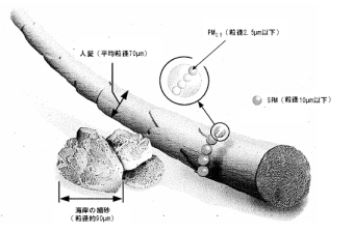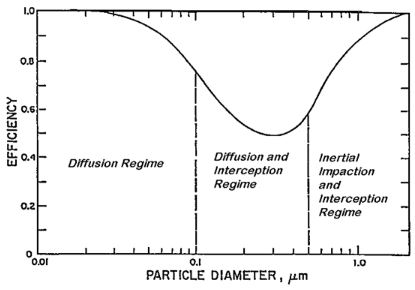RADIASK™ - Disposable Particulate Filtering Surgical Face Masks Media
Respirator Classification
The nine classes of filters defined by OSHA are broken down into three series; N, R and P. All three series have efficiency levels of 95%, 99% and 99.97%.
R Series - are resistant to oil, which means it will filter out any particle including oil based liquid aerosol. They may be used for any solid or liquid airborne particulate hazards. This respirator should only be used for no more than 8 continuous hours. Extended use is possible if workplace setting doesn't degrade the efficiency of the respirator. R95 respirators have at least a 95% efficiency level.
P Series - P95 respirators should be selected if there are oil aerosols. They may be used for any solid or liquid particulate airborne hazard. This respirator can be used and reused based on damage, user hygiene and increased breathing resistance. NIOSH recommends disposal of the P95 respirator after 40 hours or 30 days of use, whichever comes first. The P95 respirator has at least a 95% efficiency level.
United States NIOSH standards define the following categories of particulate filters
Oil resistance |
Rating |
Description |
Not oil resistant |
N95 |
Filters at least 95% of airborne particles |
N99 |
Filters at least 99% of airborne particles |
N100 |
Filters at least 99.97% of airborne particles |
Oil Resistant |
R95 |
Filters at least 95% of airborne particles |
R99* |
Filters at least 99% of airborne particles |
R100* |
Filters at least 99.97% of airborne particles |
Oil Proof |
P95 |
Filters at least 95% of airborne particles |
P99 |
Filters at least 99% of airborne particles |
P100 |
Filters at least 99.97% of airborne particles |
| *No NIOSH approvals are held by this type of disposable particulate respirator. |
P100 respirator masks are commonly referred to as HEPA filters or HEPA face masks.
The degradation categories (N-, R-, and P-series) will be determined by using either sodium chloride (NaCl) or dioctyl phthalate (DOP) as the test aerosol. NaCl is only slightly degrading to filter efficiency, whereas DOP is very degrading. Respirators tested with NaCl (i.e., N-series filters) are not resistant to efficiency degradation by oils and should be used only in workplaces free of oil aerosols. Filters passing DOP oil tests (i.e., R- and P-series filters) are resistant to efficiency degradation and can be used for protection against any aerosols (including oil-based particulates) in the workplace.
Our products are coated with a proprietary zeolite based formula and are HEPA tested. Zeolite based technologies are currently being used by TEPCO in the clean up at Fukushima and amazingly, the U.S. FDA generally regards zeolites as safe (GRAS) enough for human consumption (in reference to the use of zeolite coated disposable particulate respirators (face masks) by the general public). The fact that we can extract particulates as small as .3 microns is significant! For instance, PM 2.5 (microns), VOCs and NOx are major interboundary air pollutants that comes from burning fossil fuels such as coal and automobile emissions (diesel in particular) are major contributors to respiratory diseases, worldwide. Furthermore, the decommissioning of the Dai Ici facility in Fukushima, Japan will continue to produce airborne radioisotopes of cesium and strontium for quite some time. Natural wind convection will cause these radioisotope contaminant levels to rise and fall from time to time over the entire country. This is a meteorological fact (Radiation 300 miles from Fukushima – May 28, 2011 09:58 Moscow Times)!

PMの大きさ(人髪や海岸細砂)との比較(概念図)(出典:USEPA資料)
PM2.5の生成メカニズム (出典: JapanTimesonline.com - 4052013)

Figure 2: Filter efficiency versus particle diameter
How are surgical masks and respirator filters tested?
Respirator filters must meet stringent certification tests (42 CFR Part 84) established by NIOSH. The NIOSH tests use what are considered “worst case” parameters, including:
-
A sodium chloride (for N-series filters) or a dioctyl phthalate oil (for R- and P-series filters) test aerosol with a mass median aerodynamic diameter particle of about 0.3 µm, which is in the MPPS-range for most filters
-
Airflow rate of 85 L/min, which represents a moderately-high work rate
-
Conditioning at 85% relative humidity and 38°C for 24 hours prior to testing
-
An initial breathing resistance (resistance to airflow) not exceeding 35 mm water column* height pressure and initial exhalation resistance not exceeding 25 mm water column height pressure
-
A charge-neutralized aerosol
-
Aerosol loading conducted to a minimum of 200 mg, which represents a very high workplace exposure
-
The filter efficiency cannot fall below the certification class level at any time during the NIOSH certification tests
* Millimeters (mm) of water column is a unit for pressure measurement of small pressure differences. It is defined as the pressure exerted by a column of water of 1 millimeter in height at defined conditions, for example 39°F (4°C) at standard gravity.
As a result of these stringent performance parameters, fiber diameters, porosity and filter thicknesses all particulate filters used in NIOSH-certified respirators, including N95s, are designed and engineered to provide very high levels of particle collection efficiencies at their MPPS.
Back to Products
|

